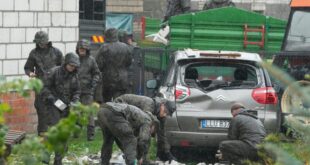After the Cold War, Europe acquired praise as the zone of peace and stability. Solemn proclamations of the region as a “common home” were accompanied by massive reductions in the size of militaries, defence budgets, and weapon inventories. European states launched multiple venues for dialogue, confidence-building measures, and arms control arrangements. Such initiatives as Vienna Document, Open Skies Treaty or Cooperative Threat Reduction Program heralded unprecedented transparency of national security establishments. Leaders debated the parameters for new relations and common spaces.
This sense of tranquillity in Europe was deceptive. The end of the Cold War did not resolve the structural problems of regional architecture. International institutions aggravated divisions instead of resolving them. Burgeoning cooperation remained fragile as it did not address the core security concerns. As a result, Europe experienced increasing tensions, culminating in a direct clash between Russia and the West over Ukraine in 2022. The facade of regional order gave way to the most intense conventional conflict since the Second World War, with a threat of nuclear confrontation.
As the famous saying goes: “Never let a good crisis go to waste.” Recent developments, however painful and tragic, provide valuable lessons not only for Europe but also for other regions, especially Asia. The latter hosts a plethora of ambitious powers and experiences rising tensions. Meanwhile, the downfall of the European security architecture reveals deficiencies in the scholastic dogmas which even politicians sceptical of academic theorising recite uncritically. The following sections will outline three lessons from the Russian-Western confrontation that contradict what was so far believed by experts:
Bipolarity is no recipe for stability
The second half of the 20th century witnessed a harsh rivalry between the erstwhile Soviet Union and the United States (US), which did not lead to a major war. Eventually, these superpowers reached a modus vivendi, acquiring a sense of stability in confrontation. In the subsequent decades, this equilibrium even encouraged sentimental references to the Cold War as a period of relative predictability. A prominent theoretical treatise by Kenneth Waltz praised the bipolar structure for reducing miscalculations, recklessness, and free riding. Effectively, it positioned bipolarity as the remedy against major wars.
The end of the Cold War signified the demise of bipolarity globally but did not bring the same structural shift in Europe. The regional architecture remained bipolar with Russia and the West as the dominant players. Moreover, the preservation of NATO inevitably alienated Moscow. It meant that the Western designs offered Russia merely access to an entry lobby while the latter demanded a seat at the table. This collision placed an irremediable flaw in the very foundation of the European order.
Meanwhile, real-world bipolarity does not ensure the solid incorporation of every state into antagonistic blocs, contrary to the schemes of abstract theorising. Instead, this structure comprises unsteady elements which invite destabilising struggles. The rosy representations of the Cold War usually omit such instances as West Berlin, Korea, Vietnam, or Afghanistan. In the 21st century, these weak points triggered the downfall of the regional security architecture in Europe. As Russian-Western relations grew tenuous, ‘countries in-between’ became the primary arena for competition.
In comparison, Asia achieved greater success than Europe in overcoming the Cold War legacy. The historic decision of ASEAN to incorporate former Soviet allies signified a step beyond past feuds. However, the regional dynamic changed in recent years as competing dialogue formats and initiatives took shape, posing as forerunners to potential blocks. Although the urge to cooperate with like-minded partners is natural, it exaggerates differences with those excluded, solidifying divisions. Henceforth, Asia faces the risk of falling into the same trap of bipolar animosity that plagued Europe.
Institutions are what states make of them
Another mantra of international relations scholars is that international institutions foster information exchanges and mutual trust, leading to greater predictability and cooperation. This premise also dates to the Cold War era, when intra-Western relations relied heavily on a network of political, security, and economic regimes. The praises of international institutions heavily infiltrated the rhetoric of politicians and diplomats as such venues conferred on them a sense of agency through the flows of regular meetings and negotiated documents.
After the Cold War, Europe saw an explosive growth of institutions. The Council of Europe, European Union (EU) and NATO expanded to the East. The Conference on Security and Cooperation in Europe was rebranded into an organisation, although not receiving full legal credentials. Subregional organisations mushroomed. All these bodies did not prevent the downfall between Moscow and the West. Illustratively, the Russia-NATO Council entitled to keep security dialogue came on hold amidst crises. Institutions also contributed to tensions by providing a podium for the exchange of blame, and extensive regulations as fuel for disputes.
Asia witnessed a similar rise in international institutions over the last decades. They differed from their European counterparts due to the less emphasis on advancing binding regulations. This flexibility helped to avoid some of the same controversies. Nevertheless, it would be naïve to expect such institution to provide solutions for caging potential conflicts. No amount of information exchanges would suffice in cases of substantive differences between states. Moreover, multilateral fora in Asia have already invited heated encounters in recent years. Thus, they serve confrontation as much as cooperation.
Political fears trump economic rationale
Finally, the last dogma overturned by the Russian-Western clash is the pacifying role of economic interdependence. The argument that trade makes war foolish predates the First World War, but it received additional resonance with the rise of global supply chains, international finance, and information flows. Increasing economic interdependence combined with transnational people-to-people contacts increased the costs of confrontation for states, encouraging expectations that they would be forced to solve their differences through political tools.
Both Russia-Ukrainian relations and Russia-EU ties relied on solid economic foundations. Throughout the post-Cold War years, Moscow and the West faithfully trusted that the promotion of trade and investment would bring them close politically. Nord Stream pipelines became an embodiment of these beliefs. Once tensions started to mount, parties came to similar inferences, which, however, contradicted predominant expectations. Each assumed that potential losses would make the other side concede and, therefore, each doubled down on its claims. Economic interdependence encouraged brinkmanship rather than compromise.
Economic ties connecting Asian states are in certain respects more profound and complex than those that bound Russia and the West. However, they are no less confusing for political calculations. As interdependence is mutual, it incentivises reckless behaviour as much as risk aversion. Given that decision-makers tend to overestimate their commitment relative to opponents, especially in security matters, their perspective on economic ties creates reasons for worry.
Is Asia different?
One can argue that inferences from the Russian-Western confrontation imperil excessive generalisations. The fact that bipolarity, international institutions, or economic interdependence produced poor results in this case, does not mean that they are always perilous. After all, Asia vastly differs from Europe in terms of geography, history, and strategic cultures. However, even if there are reasons to believe that international relations in one region do not necessarily follow the failures in the other, nothing precludes decision-makers from learning from the latter and applying these lessons creatively.
The bottom line is that many of the established dogmas can be misleading. They require critical assessment even if they are supported by reputable academic justifications (usually from Western theoretical literature). The European record played a significant role in bolstering predominant strategic myths. Now, it is instrumental in busting them.
 Eurasia Press & News
Eurasia Press & News




